Silvicultural analysis of the Atlantic tropical forest from the tree diameter distribution and the floristic richness
Main Article Content
Abstract
The Atlantic tropical forest is highly fragmented and in strong regression. Next to these forests there are abandoned agricultural areas in which native vegetation is regenerating. The dynamics of that natural regeneration is poorly understood. The objective of the work was to define groups of tree species based on their regeneration pattern in these areas. To do that, the diameter distribution of the tree cover of an area in natural regeneration for 33 years in a Brazilian biological reserve was analyzed by species. 195 trees (813 trees ha-1 47.8 ± 95.6 trees per hectare) were inventoried on 2,400 m2, belonging to 15 families and 17 species, with a quadratic mean diameter of 13.7 cm and basal area averaging 11.9 m2 ha-1. Although 73 % of the diameters ranged from 5 to 15 cm, the diameter distribution was satisfactorily fitted to the Gauss curve. Only five species presented more than 75 trees ha-1: Cecropia catarinensis, Miconia cinnamomifolia, and Miconia multiflora presented distribution with a tendency to normal, while Piptocarpha macropoda presented an inverted J shape; Vismia guianensis only appeared in the lowest diameter class. Integrating into a dendrogram the dispersion syndrome, ecological group, and wood density attributed to the sampled species, five functional groups were distinguished. Due to its homogeneity coefficient, the surveyed stand was classified as an uneven forest. Despite 33 years having elapsed since the start of the natural regeneration, the forest stand is still in an initial stage of its natural succession towards climax structures.
Article Details

This work is licensed under a Creative Commons Attribution-NonCommercial-NoDerivatives 4.0 International License.
Revista Forestal Mesoamericana Kurú is licensed under CC BY-NC-ND 4.0
Al enviar un artículo a la Revista Forestal Mesoamericana kurú (RFMK), los autores ceden los derechos patrimoniales a la editorial de la RFMK una vez su manuscrito haya sido aprobado para publicación, autorizando a la RFMK a editarlo, reproducirlo, distribuirlo, y publicarlo en formato físico y/o electrónico. La titularidad de los derechos morales sobre los trabajos objeto de esta cesión seguirá perteneciendo a los autores.

